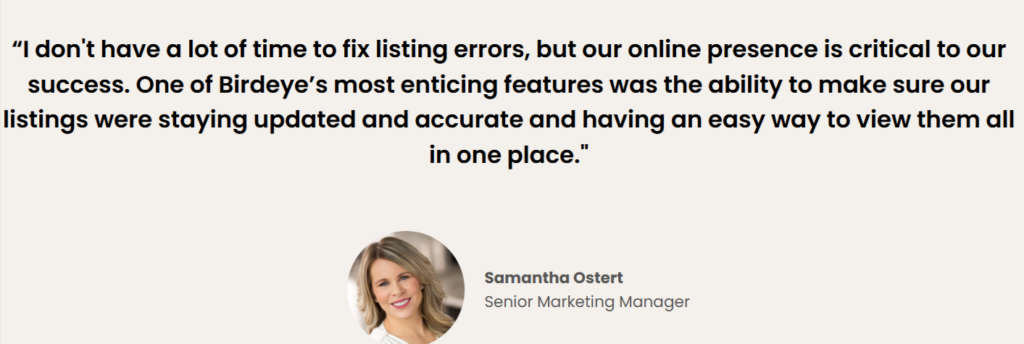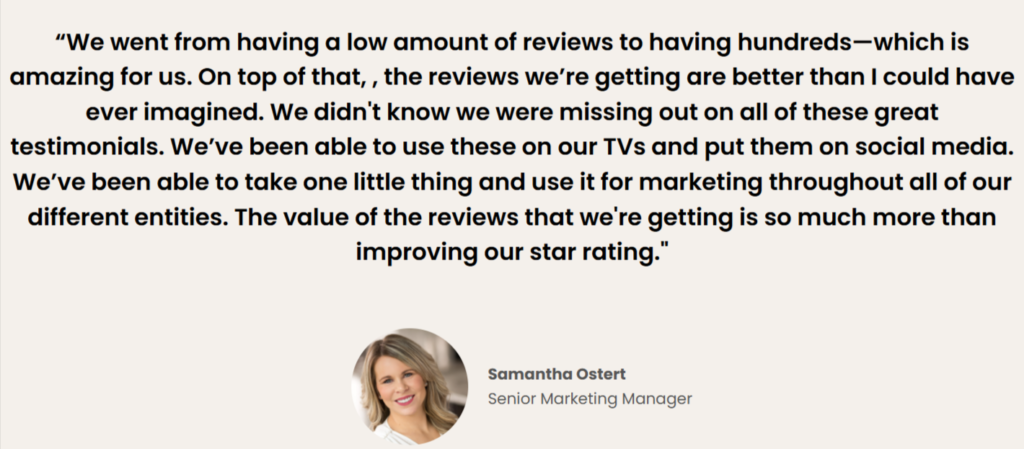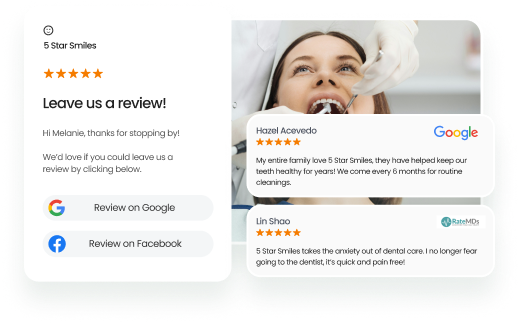In 2026, commercial property marketing is no longer just about listing a space online. Whether you manage office spaces, retail hubs, or warehouses, today’s tenants and investors expect an experience—from their first Google search to the moment they walk through the door.
In this blog, you’ll learn seven high-impact strategies to attract leads, build trust, and outperform competitors in a crowded commercial real estate (CRE) market
The deal-maker insight 💼 Relying on outdated tactics while doing commercial property marketing? You're losing out on qualified leads. In 2026, trust and digital authority move deals forward—and this blog will show you how to own both.
Table of contents
- What is commercial property marketing, and why does it matter in 2026?
- How to create high-converting listings for commercial properties
- Capture more leads with authentic reviews that build trust
- Turn browsers into long-term tenants with omnichannel lead nurturing
- Outperform competitors with AI-driven insights and real-time benchmarking
- Trends reshaping commercial property marketing in 2026
- FAQs on commercial property marketing
- Ready to elevate your commercial property marketing with Birdeye?
The playbook has changed. To connect with modern tenants and investors, commercial real estate marketers must rethink how they position properties online—and offline. Let’s explore what’s outdated and what strategies are reshaping success in 2026.
What is commercial property marketing, and why does it matter in 2026?
Commercial property marketing is the process of promoting office spaces, retail locations, warehouses, and other non-residential spaces to attract potential clients and prospective tenants. However, this process has dramatically evolved in recent years, especially in the competitive CRE market of 2026.
Today, marketing is no longer just about pushing out property listings; it’s about creating a seamless experience that combines trust, visibility, and customer engagement across every digital and offline touchpoint.

Why outdated commercial property marketing tactics no longer work
Traditionally, commercial real estate (CRE) teams relied heavily on marketing materials like print brochures, classified ads, and word-of-mouth via broker networks. While these were staples for decades, they now fall short in a space where decision-makers research properties online long before setting foot in one.
As a result, static listing sheets and one-off marketing tools no longer deliver the insights or engagement necessary to close deals.
So, what’s causing this shift?
Why modern CRE marketing wins with omnichannel and tech-driven strategies
Tenants today expect more than simple flyers and broker emails. Successful marketers now embrace an omnichannel model: blending virtual tours, optimized listings, and AI-driven personalization across digital channels. By integrating review generation and automation platforms, CRE marketing create a journey that starts online—and stays connected across every interaction.
In addition to digital assets, automation and AI now play a key role. CRE marketers use GenAI and CRM platforms to streamline and enhance their workflows, from automating follow-ups to generating data-backed content and property descriptions.
But there’s a bigger force at play here—changing customer expectations.
Top Commercial Property Marketing Strategies That Attract Customers
Want to see the impact of Birdeye on your business? Watch the Free Demo Now.
How have customer expectations shifted post-2020?
Since 2020, tenant behavior has evolved significantly. Flexible lease terms, hybrid workspaces, and increased demand for transparency have become the norm. Now, potential tenants expect instant access to accurate information, from virtual tours and reviews to clear property details on listings.
Furthermore, they prioritize speed and convenience, including:
- The ability to book tours online
- Initial digital exploration before committing to in-person tours
- Assurance that the business has a positive online reputation, which impacts their comfort level during the leasing process
In short, you can no longer rely on a single brochure or outdated listing to win over modern tenants. Instead, the next step is building property listings that don’t just rank high on search engines but also convince browsers to become prospects.
How to create high-converting listings for commercial properties
A high-performing property listing is no longer a static page with bullet points and contact info. In 2026, a listing acts as your digital storefront—and it can either bring in qualified leads or get lost among competitors on search engines.
Highlight key property features with photos and video tours
Winning listings start with clear, concise property details that showcase the unique strengths of the space. Instead of generic specs, highlight what makes your property stand out—amenities, location perks, or unique features like green building certifications.
This is also where professional photography and video tours come in. Business listings featuring high-quality photos and immersive virtual tours tend to receive more inquiries and longer engagement times.
But strong visuals alone aren’t enough…
Distribute listings across platforms to boost visibility
To truly generate interest and reach your target audience, you need to ensure your listings are everywhere prospects are searching. That means going beyond your website to publish on platforms like:
- Google Business Profiles
- Apple Maps & Place Cards
- LoopNet, CoStar, CREXi, Bing Places
Birdeye’s Listings AI helps multi-location businesses respond quickly. It updates listings across platforms automatically. It also fixes errors and creates AI-generated descriptions to rank higher on search engines.
How Skogman Companies improved local visibility with Birdeye
Challenge:
Skogman Companies, a leading property management group, struggled with inconsistent listings across multiple platforms. This negatively impacted their SEO rankings and caused confusion for tenants searching online.
Solution:
They implemented Birdeye Listings AI to manage listings for all their properties. The platform helped automate listing accuracy and syndication across key directories like Google and Apple while providing insights on keyword performance.
Customer success spotlight:
✅ 4k increase in Google Maps views
✅ 10.1k increase in direct website visits
✅ 91.4k increase in profile impressions

Just like Skogman Companies, you can simplify your listing workflows while driving better local visibility—and that’s only one step toward a fully optimized CRE marketing strategy.
Boost engagement with interactive content and AI
Modern tenants expect more than text and images. Add virtual tours, 3D walk-throughs, drone footage, and even interactive maps to your listings. These tools enhance engagement and reduce friction by allowing prospects to pre-qualify spaces before requesting an in-person tour.
You can further drive engagement by directly embedding appointment request links, reviews, and calls to action into your listings, streamlining the lead-generation process.
But even the best listings won’t drive conversions if prospects don’t trust your brand. That’s why building credibility through reviews is your next crucial move.
Capture more leads with authentic reviews that build trust
Your listings are live, but how do you convert browsers into inquiries? The answer lies in trust. In real estate marketing, trust is earned through authentic customer feedback.
For many potential clients, online reviews now play a central role in the decision-making process. Before reaching out, they look at how other businesses and tenants describe your services.
Why reviews influence every lead
Modern prospective tenants are cautious. They compare businesses and properties online before booking a tour, and reviews and ratings influence their decisions more than glossy marketing materials ever could.
Here’s what tenants expect to see:
- High star ratings across Google, Yelp, and industry directories
- Consistent reviews across locations to build online reputation
- Quick, professional responses to both positive and negative feedback
Reviews help you:
- Build confidence and build brand awareness
- Position your property as reliable and tenant-friendly
- Differentiate from competitors in your target market
Your marketing efforts are more effective when backed by social proof. This builds trust at the very first touchpoint—your listing.
How to capture and use reviews effectively
You need a structured plan to effectively market your reputation. Here’s how leading CRE teams do it:
- Automate review generation requests after every tour or inquiry.
- Use GenAI to draft review responses at scale while keeping a human touch.
- Embed reviews directly into your property listings using widgets.
- Repurpose top reviews for email marketing, social posts, and brochures.
For example, Birdeye Reviews AI automates these processes. It helps multi-location CRE firms gather more reviews, respond faster, and display testimonials across their marketing channels.
Skogman Companies didn’t just improve their listings—they also streamlined review management. They faced low review volumes and inconsistent responses across their property portfolio. This limited their online visibility and tenant trust.
Solution:
In addition to using Listings AI, Skogman implemented Reviews AI to automate review requests and manage responses from a centralized dashboard.
After 15 months with Birdeye, Skogman Companies saw:
- 149% increase in reviews
- An average star rating of 4.9
- Improved review response times by 40%
Read how Birdeye GenAI amplified its impressive reputation:

How reviews also improve discoverability
Reviews don’t just build trust—they also boost local SEO. Listings with a high volume of positive reviews rank higher on search engines like Google and Bing. More importantly, they increase engagement.
This means you’re not only attracting potential tenants but converting them too.
Once trust is established through reviews, the next step is to nurture those leads across multiple touchpoints. Let’s explore how an omnichannel approach helps convert browsers into tenants.
Turn browsers into long-term tenants with omnichannel lead nurturing
Capturing leads is one thing. Converting them into long-term tenants requires a smarter, multi-channel approach. In commercial real estate marketing, prospects need multiple touchpoints before committing to a lease.
That’s where nurturing through content, automation, and digital channels comes in.
Guide prospects across every stage of their journey
Today’s CRE teams effectively market properties by meeting prospects on their existing platforms. Instead of relying on one-off campaigns, marketers focus on long-term strategies that align with core business objectives.
Here’s how to nurture leads across multiple touchpoints:
- Develop a real estate marketing plan with targeted social, email, and content strategies.
- Share local market reports and company news via email campaigns and social feeds.
- Build relationships by promoting success stories, press releases, and client testimonials.
- Align content with investment opportunities that appeal to both potential investors and tenants.
For example, marketing objectives for commercial real estate should include blending educational content with sales outreach. Providing insights into market trends, local developments, or market analysis can help prospects trust your expertise.
Automate and personalize the journey
An AI-powered CRM makes it easier to manage marketing activities. Automation lets you segment by location, industry, or customer type. This way, your campaigns stay relevant to your target market or more focused regional segment.
Birdeye Social AI can also help automate localized social media content. It empowers CRE teams to manage social media engagement at scale while nurturing audiences with the right message at the right time.
Keep your brand top of mind
- Use regular newsletters to keep potential prospects informed.
- Publish trade journals articles or blogs to share expertise.
- Announce available properties or leasing success via press releases.
Consistent messaging across platforms builds familiarity. It increases the number of leads generated and helps you generate leads from potential buyers and investors.
While nurturing leads is key, analyzing what’s working—and where competitors are falling behind—is just as crucial. Let’s see how data and AI marketing strategies transform.
Outperform competitors with AI-driven insights and real-time benchmarking
Staying ahead in CRE marketing means knowing where you stand—and where your competitors fall short. In commercial real estate marketing, data isn’t optional. It’s the foundation for smarter campaigns and stronger positioning.
Modern marketers rely on data-driven decisions to adjust strategies and target the right leads. Competitive intelligence helps you find gaps, spot trends, and refine your value proposition.
Benchmark your performance against the competition
Start by analyzing key factors:
- Compare your online reputation to other commercial real estate brokers.
- Review competitor listings, social activity, and review ratings.
- Track your key metrics like listing views, engagement, and review response times.
Birdeye’s Competitors AI helps identify which competitors outperform you on review volume, sentiment, and social reach.
Adapt to changing market dynamics
Your team should monitor real-time market conditions. This includes shifts in demand, rental rates, and regional trends.
Tools like Birdeye’s Insights AI give you a clear view of:
- What tenants like or dislike (sentiment analysis).
- Trends emerging in your more focused regional segment.
- How your properties compare to competitor portfolios.
These insights allow you to optimize campaigns based on what matters most to your target market.
Make insights actionable
AI lets your team act fast. Adjust your real estate marketing plan to align with competitor weaknesses or gaps.
For example:
- Launch new campaigns when rivals reduce marketing spend.
- Refine listings based on competitor keyword analysis.
- Identify high-performing locations or units for extra promotion.
Whether you’re a marketer or a real estate agent, competitive intelligence is critical to closing more deals.
Once you’ve optimized your strategy based on market intelligence, it’s time to understand how larger trends are shaping CRE marketing in 2026.
Trends reshaping commercial property marketing in 2026
The commercial real estate landscape is evolving fast. The following five trends are shaping how properties attract leads, earn trust, and stay ahead in a competitive market.
1. CRE personalization and localized strategies
Tailored messaging performs better than generic promotions—especially at the local level.
- Customize campaigns by property type (e.g., flex, retail, medical) to address specific tenant needs.
- Use regional data like traffic flow, neighborhood demographics, and walk scores to refine outreach and listing descriptions.
2. ESG and sustainability becoming deal-breakers
Tenants and investors are prioritizing environmentally responsible spaces more than ever.
- Highlight green certifications (like LEED, ENERGY STAR, or WELL) prominently in listings and marketing materials.
- Share sustainability reports, water usage stats, or carbon reduction efforts to attract values-driven prospects.
3. Content marketing beyond listings
CRE teams are becoming publishers, not just promoters.
- Publish blogs, thought leadership articles, and client success stories to build trust and demonstrate market expertise.
- Share video walk-throughs, drone footage, or market reports to increase social reach and listing engagement.
These tactics help CRE brands stay top of mind and increase social media engagement.
4. Reviews and reputation as SEO drivers
Strong reputations win in both search rankings and tenant decision-making.
- Automate review requests and make it easy for tenants to share feedback post-tour or post-lease.
- Embed top reviews into listings and use them in outreach emails and social posts to build credibility.
5. AI and automation adoption across CRE
CRE teams are scaling faster and smarter using AI-driven marketing tools.
- Use GenAI to auto-generate listing descriptions, review responses, and social media captions across properties.
- Analyze market sentiment, competitor performance, and campaign ROI using AI dashboards to stay agile.
FAQs on commercial property marketing
It’s promoting commercial spaces to attract tenants, investors, and local businesses interested in leasing or purchasing properties.
Use an omnichannel strategy that blends optimized listings, reviews, social media, and automated lead nurturing. Combine digital tools with traditional marketing activities like direct mail or attend industry events and partnerships with local businesses.
Local SEO boosts your visibility on Google search and other platforms. Optimized listings with consistent NAP info, positive reviews, and engaging content help you rank higher and drive more inquiries.
Trust is built through authentic reviews, transparent online listings, community engagement, and strong press releases or company news that position you as a credible business.
Positive reviews build trust and encourage prospects to sign faster. Many businesses look for social proof before committing to a property leased.
Firms are testing new ideas such as virtual open houses, AI-driven listing updates, and integrating ESG initiatives into their messaging.
Here’s how Birdeye’s GenAI solutions can give your team an edge.
Ready to elevate your commercial property marketing with Birdeye?
Every marketing budget needs to deliver results which requires more than traditional tactics. Birdeye helps multi-location businesses enhance every aspect of their marketing funnel—from visibility to trust to conversion.
With Birdeye, your team can attract potential tenants and potential buyers while improving efficiency:
- Listings AI: Manage and update listings across Google, Apple, Yelp, Bing, and other platforms.
- Insights AI: Get AI-generated reports on customer sentiment and competitive benchmarks.
- Reviews AI: Automate review collection and improve online reputation and SEO.
- Social AI: Automate localized social content across multiple platforms.
- Competitors AI: Track and analyze competitors’ performance to refine your real estate marketing plan.

Originally published









